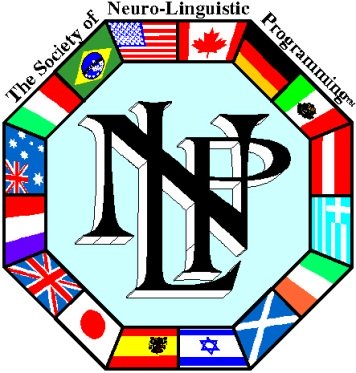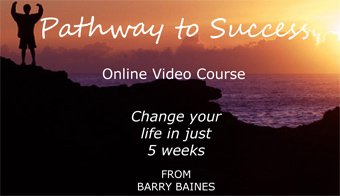NLP techniques
States - NLP secret
NLP techniques relating to states has nothing to do with where you live and everything to do with your emotional state.
Did you wake up this morning feeling full of the joys of spring and raring to go, tired and listless, or generally grumpy? Each of those feelings represents your emotional state.

Success is a state of mind. If you want success in this world, start thinking of yourself as a success.
The emotional state within
If you feel happy you tend not to think anything more about it but get on with enjoying the day.
But if you are in what I might describe as a negative state, you tend to wonder what has happened to you and cast your eyes around for something or someone to blame.
The state, however, whichever one it is, did not arise because of something outside of you. It arose within you.
The good thing to know is that because the state arose inside you instead of outside you, you can do something about it.
That is to say, you can change the state. In fact, our states tend to change during the course of a day anyway, but knowing that you have the power to change is very useful.
NLP techniques – what is stopping you?
The more you consider emotional states the more you realise how they may hamper or improve our lives at any given moment.
What prevents so many people from speaking effectively in public? Or singing? Or playing a musical instrument? It is their emotional state.
Most people do not have any trouble talking one to one or even in general conversation. Most people don’t have a problem singing in the shower if they believe there is no-one else around to hear them.
And others are happy practising a musical instrument on their own. But put them in front of an audience and they become a bag of nerves and their performance is badly affected.
NLP techniques – boredom and anxiety
They are not the only states that affect people for the worse. Boredom is one of the principal factors that prevents students from learning. Anxiety stops some people from flying, travelling in elevators or learning to swim.
If the state can be changed – and I assure you a good coach or teacher can assist you to change your state – you start to think differently. Animated, interested students begin to learn because their curiosity is aroused.
People start to enjoy travelling in aeroplanes and get used to elevators because their attention is elsewhere, and one a person can swim he no longer thinks about the water.
NLP techniques – affecting your state
You can affect your own state and the state of those
around you by one simple habit you can start practising today. Get
used to smiling.
That may be something that comes naturally to you in any event.
I know a number of people who smile every time I meet them. I like to be around them. They make me feel good.
But I also know others who rarely, if ever, smile and do nothing but moan. I don’t enjoy their company and I try to avoid them.
People who smile make us feel good. So much of our life is about good feelings. If you wish to attract people to you, smile.
If you smile at someone and they smile back, your own feeling is enhanced, isn’t it? If you aren’t used to it, start it now and see how life improves.
NLP techniques – experiencing the world differently
We experience the world in different ways, and in NLP we refer to our states as either associated or dissociated depending whether we see the experience from the inside or the outside.
If, when we think about an experience, we see ourselves in the picture performing the experience, we say we are dissociated because we have feelings about the experience.

If, instead, we see the experience through our own eyes as if we are caught up with it or in it, then we say we are associated because we have the feelings that actually go with the experience.
NLP techniques – an exercise
I don’t know where you are while you are reading this. A lot of readers will be viewing the page on a desktop computer or laptop.
Others may be reading it on ipads or electronic tablets of some sort, and still others may have printed off the page and carried it off to read in some unimaginable place.
You could be at home, on a train, in the middle of a field or on a beach for all I know.
Wherever you are, try this if you are able to sit down for a moment.
Close your eyes. If you think about yourself you can only image yourself inside your body – that is, in an associated state.
Imagine yourself rising out of your body, floating up and looking down on yourself from in front and to the left.
Then float across to the right and have a look. Then repeat the experience from the same sorts of angles from behind yourself.
When you see yourself in that way you are in a dissociated state. You can now float back down into your body knowing that your body didn’t go anywhere but your perception did.
You will realise then that association and dissociation are descriptions of the different ways we see the world.
When I think of the wonderful times I have enjoyed with my wife and children over the years and the different places we have been together, I envisage those experiences through my own eyes.
NLP techniques – associating the good experiences
When I remember playing soccer and making saves as a goalkeeper, playing cricket and scoring runs as a batsman, playing golf and teeing off or chipping to the green, and swimming smoothly through the water, I see all those pleasant images in an associated state.
NLP techniques – dissociating the bad experiences

When I think about events that have occurred in my life where things didn’t quite go according to plan or where I have been disappointed or the experience was unpleasant, I am more likely to view the images in a dissociated way.
The feeling is inclined to be stronger when you are associated because you are on the inside looking out. But dissociated feelings remove you from the experience because they are about what you see.
That is why when you want to remove or diminish a bad memory, we see ourselves in the picture and push it off into the distance.
NLP techniques – another exercise
You might like to perform this exercise to see where you associate and dissociate. Think first of a good memory and look at the mental picture that conjures up. Are you in the picture?
Or are you looking at the picture through your own eyes. Whether you are in it or out of it, change it and see if your feelings change.
Finally, change it back to the way it was originally and consider which you like best.
Gain FREE access to my self-confidence video
To gain free access to my self-confidence video enter your email address and first name in the box below. This will also keep you up-to-date with my free newsletter Inspirations.
As a bonus for subscribing you'll receive the first three chapters of my book Towards Success, where you can learn more about NLP techniques, from Anchors to Modelling, and my 50 favourite inspirational quotations.
Return from NLP techniques - States to
The Secret of Mindpower & NLP Home
Return to Site Search & Contents Page

Change your life in just 5 weeks
Discover the pathway to success with my online video course. Learn more

Download NEW ebook Your Genius Within and find out how to uncover your own inner genius

NLP Articles
- Anchors
- Anchors explained
- Anger Management tips
- Anxiety Panic Attacks
- Beating disappointment
- Beating drug addiction
- Best self-help book
- Big events
- Body control module
- Body language attraction
- Body language flirting
- Body language in communication
- Body language interpretation
- Body language of a liar
- Body language signs
- Boost self-confidence
- Building Rapport
- Changing bad habits
- Changing beliefs
- Changing States
- Children
- Christmas (Holidays)
- Christmas & New Year greetings
- Chronic pain management
- Conquering Fear
- Crohn's Disease
- Cure for a Phobia
- Deal with your fear
- Deletion
- Determining your destiny
- Developing your senses
- Disaster to Triumph
- Distortion
- Drawing the line
- Embedded Commands
- Enthusiasm
- Exams
- Expecting the Best
- Expert Relationship Advice
- Eye accessing cues
- Fear of driving
- Fear of elevators
- Fear of flying
- Fear of the dentist
- Fear of vomiting
- Fear, Mental Blocks & Hesitation
- Fear, Uncertainty and Doubt
- Fight or flight response
- Finding Solutions
- Forever Worried?
- Friendly persuasion
- Generalisation
- Get the life you want
- Getting lucky
- Getting over your past
- Goal Setting Tips
- Goal Setting Tools
- Goal Setting Tools, More
- Great self-help books
- Grief
- Happy retirement
- Healthy Mind
- High blood pressure
- How long will I live?
- How to be lucky
- How to read body language
- Hypnosis & NLP
- Hypochondria
- Imagining perfect performance
- Improving speed reading
- Instant Mood Lift
- Interviews
- Knowing yourself
- Learn NLP
- Life Values
- Maintaining weight loss
- Make you thin
- Making it happen
- Managing change
- Meddling Mom
- Meeting People
- Mental rehearsal techniques
- Meta Model
- Metaphor
- Modelling
- Modelling Genius
- More NLP techniques for weight loss
- NLP Books
- NLP Courses
- NLP Practitioner Course
- NLP Master Practitioner Course
- NLP Secret
- NLP jargon buster
- NLP Modelling helped me
- OCD symptoms
- OCD treatment
- Overcoming low self-esteem
- Overcoming stage fright
- Pacing & Leading
- Persuasion
- Presuppositions
- Presuppositions (2)
- Problem solving
- Public Speaking
- Reaching agreement
- Reframing
- Self-confidence
- Self limiting beliefs
- Self-image
- Sportsmen Guide
- Stage fright tips
- Stammering
- States
- Stop binge eating
- Stop Smoking
- Subliminal Persuasion
- Success Principles
- Techniques for persuasion
- Techniques for weight loss
- The meaning of NLP
- Time & NLP
- Towards
- Towards & Away
- Ulcerative colitis
- Weight Loss
- Weight loss techniques
Articles on HYPNOSIS:
- Big events
- Conversational Hypnosis
- Covert hypnosis
- Deepening self-hypnosis
- Depression Hypnosis
- Handshake interrupt
- How to do self-hypnosis
- How to hypnotise your audience
- Hypnosis and Weight Loss
- Hypnosis NLP
- Hypnosis: Right or Wrong
- Hypnosis Stories
- Hypnotic language
- Hypnotism Stories
- Hypnosis story for you
- Hypnosis to quit smoking
- Instant self-hypnosis (age regression)
- Practical self-hypnosis
- Self-Hypnosis
- The Milton Model
Articles about THE SECRET of:
- Abundance Mentality
- Achieving more
- Beating Domestic Violence
- Being bothered
- Being Happy
- Best Self-help Book
- Conquering road rage
- Coping with criticism
- Dealing with pride
- Defeating stress
- Discover the secret of wealth
- Genius
- Getting off to sleep
- Getting over a break up
- Getting over your temper tantrum
- Health
- How to deal with grief
- Imagination
- Influence
- Love
- Making Money
- Managing others
- Memorising a Deck of Cards
- Memory
- My Success
- Organising Memory
- Overcoming tiredness
- Overcoming worry
- Perpetual energy
- Remembering
- Secret Law of Attraction books
- Sleeping well
- Speed Reading
- Super Memory
- Surviving a recession
- Surviving negativity
- The Secret Law of Attraction
- Towards
- Teachers of the Secret
- Waiting for God
- Wealth Building
- Weight Loss
Articles on WEIGHT LOSS:
- Best Weight Loss Plan
- Body control module
- Easy weight loss
- Hypnosis and Weight Loss
- Maintaining weight loss
- More NLP techniques for weight loss
- NLP techniques for weight loss
- NLP techniques to make you Thin
- NLP weight loss techniques
- Stop binge eating
- The Secret of weight loss
- Weight control help
- Weight loss tips
- Why have I lost weight?
Articles on WEALTH:
Articles about RELATIONSHIPS:
- Beating domestic violence
- Body language flirting
- Expert relationship advice
- Healthy family relationships
- Hurt feelings
- Love
- Relationship problem advice
- Signs of true love
- The secret of getting over a break up
Articles about COACHING:
- Barriers to effective communication
- Communication
- Executive Business Coaching
- Feedback
- Free interview tips
- Free Life Coaching
- Goal Setting Tips
- Goal Setting Tools
- Goal Setting Tools, More
- Life & Executive Coaching
- Personal Development Plan
- Problem solving
- Success Principles
- The Secret of my Success
- Time Management
Articles on GENIUS and MIND POWERS:
- Activating genius
- Become a genius
- How long will I live?
- Mind Powers
- Misty Reflections
- Modelling Genius
- The Secret of Genius
Real Men of Genius Articles:
- Abraham Lincoln
- Albert Einstein
- Antoni Gaudi
- Carl Jung
- Charles Darwin
- Charles Dickens
- Christopher Wren
- Confucius
- George Washington
- Hannibal
- Horatio Nelson
- Isaac Newton
- Julius Caesar
- Lawrence of Arabia
- Leonardo da Vinci
- Michelangelo
- Mohatma Gandhi
- Napoleon Bonaparte
- Nicolas Copernicus
- Oscar Wilde
- Rembrandt
- Robert Burns
- R L Stevenson
- Socrates
- Walt Disney
- William Shakespeare
- Wolfgang Amadeus Mozart
Real Women of Genius Articles:
Articles on SECRET and INSPIRATIONAL TEACHERS:
- Bill Harris
- Bob Proctor
- Dr John F DeMartini
- Hale Dwoskin
- Jack Canfield
- Joe Vitale
- John Assaraf
- Lisa Nicholls
- Michael Bernard Beckwith
- Stephen R Covey
Articles about MEMORY:








New! Comments
Have your say about what you just read! Leave me a comment in the box below.